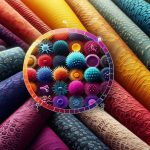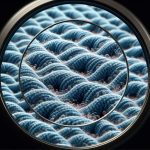Imagine you're in a hospital where every textile surface, from bed linens to surgical gowns, actively fights against infection. That's the promise of the latest advancements in antimicrobial fabrics. These materials, treated with agents like silver ions and triclosan, don't just sit passively but actively inhibit bacterial growth, reducing healthcare-associated infections. With the healthcare industry constantly pushing for better patient outcomes and cost efficiency, these innovative textiles are a game-changer. But how exactly do they work, and what specific benefits do they bring to different medical environments?
Table of Contents
Key Takeaways
- Advanced coatings in antimicrobial fabrics offer long-lasting protection by disrupting bacteria cell walls.
- Integration of silver ions and other agents into fabric fibers ensures durable antimicrobial effectiveness.
- Surgical gowns and drapes made from antimicrobial textiles maintain sterility and prevent pathogen transfer.
- Nanotechnology enhances the antimicrobial properties of fabrics, ensuring higher hygiene levels.
- Eco-friendly production of antimicrobial textiles emphasizes sustainability and environmental impact reduction.
Understanding Antimicrobial Fabrics
Antimicrobial fabrics are designed to inhibit the growth of bacteria, fungi, and other microorganisms. When you explore the realm of fabric technology, you'll realize just how groundbreaking these textiles are in infection prevention. These fabrics aren't just about adding a layer of protection; they're about fundamentally altering how we perceive hygiene and safety in environments prone to contamination.
The essence of antimicrobial fabrics lies in their treatment processes. They often undergo a rigorous application of antimicrobial agents, which can include silver ions, triclosan, or other chemicals known for their biocidal properties. This isn't simply about coating the fabric but integrating these agents into the fibers themselves, ensuring long-lasting effectiveness.
You might be wondering how this impacts infection prevention. By halting microorganisms in their tracks, these fabrics reduce the risk of cross-contamination, a key factor in maintaining sterile environments. Additionally, this technology helps in controlling odors and extending the lifespan of the textiles, making them both practical and economical.
To excel in understanding antimicrobial fabrics, focus on comprehending the specific agents used and the methods of their application. This knowledge will empower you to make informed decisions in selecting and utilizing these advanced materials.
Key Benefits in Healthcare
In healthcare settings, these innovative fabrics play an essential role in reducing infection rates and enhancing patient safety. Antimicrobial textiles are engineered to prevent the growth of harmful bacteria, fungi, and viruses, making them a cornerstone in infection prevention.
By integrating these fabrics into hospital linens, uniforms, and patient gowns, you're notably lowering the risk of healthcare-associated infections (HAIs).
Not only do these textiles contribute to a safer environment, but they also offer substantial cost efficiency. Fewer infections mean reduced hospital stays and less need for expensive treatments, which translates to improved outcomes for both patients and healthcare facilities.
The long-term financial benefits of investing in antimicrobial fabrics are clear: you'll save on medical expenses and enhance the overall quality of care.
Additionally, patient comfort is another key benefit. These fabrics are designed to be soft, breathable, and durable, providing a more comfortable experience for patients during their recovery.
Comfortable patients are more likely to rest well and heal faster, further contributing to improved outcomes.
Types of Antimicrobial Textiles
You'll find a variety of antimicrobial textiles, each designed to target specific pathogens and suited for different applications in healthcare environments. Some textiles incorporate silver ions, known for their broad-spectrum antimicrobial properties. Silver ions disrupt bacterial cell membranes, making them effective for surgical drapes and wound dressings.
Another type uses copper-infused fabrics, which are particularly potent against viruses and fungi. Copper's biocidal action is ideal for surfaces frequently touched by multiple people, such as patient gowns and curtains. These fabrics offer durability and long-lasting protection, ensuring continuous antimicrobial efficacy.
Zinc-based textiles present another option. Zinc's antimicrobial properties make it effective against a wide range of pathogens, including bacteria and fungi. You'll often see zinc-infused fabrics in medical scrubs and uniforms, providing healthcare workers with an added layer of protection.
Lastly, there are synthetic fibers treated with antimicrobial agents during the manufacturing process. These textiles are versatile and can be used in various fabric applications, from masks to medical bandages. Their primary advantage lies in their customizability, allowing manufacturers to tailor antimicrobial properties to specific needs.
Hospital Linens and Bedding
When you consider hospital linens and bedding, you'll see they play an important role in enhanced infection control.
These antimicrobial fabrics not only fight off germs but are also designed to be durable and comfortable.
Enhanced Infection Control
Hospitals depend heavily on antimicrobial fabrics in linens and bedding to lessen the risk of infections. By incorporating advanced fabric technology, the healthcare industry aims to elevate infection prevention and guarantee patient safety.
You know that hospital environments are breeding grounds for pathogens, making it essential to utilize textiles that actively combat microbial growth. Antimicrobial linens and bedding are engineered to inhibit bacteria, fungi, and viruses, providing a robust layer of protection for patients and staff alike.
When you think about infection prevention, consider how these fabrics work at a microscopic level. The technology embedded in these textiles disrupts the cellular processes of harmful microorganisms, effectively neutralizing them before they can proliferate. This proactive approach reduces the risk of healthcare-associated infections (HAIs), which are a major concern for any medical facility.
Patient safety is at the forefront of every healthcare provider's mission, and antimicrobial fabrics are a pivotal component in achieving that goal. By adopting these innovative textiles, hospitals not only enhance the overall hygiene of their environments but also foster a safer, more dependable space for patient care.
It's evident that the integration of cutting-edge fabric technology is transforming the healthcare industry, making infection control more efficient than ever before.
Durable and Comfortable
Switching to antimicrobial fabrics doesn't mean sacrificing comfort and durability in hospital linens and bedding. In fact, these textiles offer long-lasting protection and innovative designs that guarantee both patient comfort and the longevity of the material. You get enhanced comfort without compromising on the enduring durability that hospital environments demand.
With advancements in textile technology, antimicrobial hospital linens are now designed to be softer and more breathable. These features are essential for patient care, as they contribute to better sleep quality and overall well-being. Plus, the long-lasting protection keeps harmful microbes at bay, reducing the risk of infections.
Here's why antimicrobial fabrics stand out:
| Feature | Benefit | Impact on Hospital Environment |
|---|---|---|
| Long-lasting protection | Reduces microbial load | Minimizes infection risks |
| Innovative designs | Improves usability | Enhances operational efficiency |
| Enhanced comfort | Increases patient rest | Boosts patient recovery rates |
| Lasting durability | Reduces replacement | Lowers operational costs |
These qualities make antimicrobial linens an essential investment for healthcare facilities. They provide a balance of comfort, protection, and cost-efficiency, guaranteeing that both patients and staff benefit from their use. By integrating these advanced textiles, you're setting a new standard in patient care and hospital management.
Surgical Gowns and Drapes
Surgical gowns and drapes play an essential role in maintaining a sterile environment during medical procedures. They act as a barrier, preventing the transfer of pathogens between medical staff and patients. This is critical for infection prevention, as even a minor breach can lead to severe complications.
Advanced antimicrobial fabrics used in these gowns and drapes are designed to kill or inhibit the growth of microorganisms, offering an extra layer of protection.
When you select high-quality surgical gowns and drapes, you're choosing materials that have been rigorously tested for their antimicrobial properties. These textiles often incorporate silver or copper ions, which are known for their potent antimicrobial effects. The integration of these ions guarantees that bacteria and viruses are neutralized on contact, further enhancing the sterile environment.
Moreover, these gowns and drapes are engineered for durability and comfort. They're breathable yet impermeable, ensuring that healthcare professionals remain comfortable during lengthy procedures without compromising on safety.
Advanced Wound Dressings
Advanced wound dressings revolutionize healing by incorporating antimicrobial fabrics that actively combat infection. You'll find these innovative dressings excel in moisture management, ensuring an ideal healing environment. By maintaining the right moisture levels, they foster faster tissue regeneration and minimize scarring. The healing properties of these advanced fabrics are unparalleled, offering not just protection but also enhanced recovery.
One standout feature is their fast absorption capability. These dressings wick away exudate efficiently, keeping the wound bed clean and reducing the risk of bacterial growth. It's essential for wound care, as excessive moisture can lead to maceration, complicating the healing process. These dressings balance moisture perfectly, which is key to effective wound management.
Moreover, these advanced wound dressings are gentle on the skin. Traditional dressings often cause irritation or damage upon removal, but these newer fabrics are designed to be minimally disruptive. You can expect a pain-free experience when changing dressings, which is crucial for patient comfort and compliance.
Face Masks and Respirators
Face masks and respirators play an essential role in preventing the spread of infections and protecting respiratory health. To guarantee their effectiveness, you must understand the production techniques and efficacy studies behind these medical textiles.
Advanced production techniques include the use of antimicrobial fabrics that inhibit the growth of pathogens. Efficacy studies have shown that these materials can greatly reduce the risk of airborne transmission, making them indispensable in healthcare settings and everyday life.
However, it's not just about efficacy; you also need to take into account the environmental impact and disposal methods. Traditional face masks and respirators are often single-use and contribute to environmental pollution if not disposed of properly. You should be mindful of the environmental footprint of these products and seek out sustainable alternatives.
For instance, some manufacturers are now producing reusable masks with antimicrobial properties, reducing waste and environmental impact. Disposal methods for single-use masks should involve proper waste management protocols to minimize their ecological footprint.
Technological Innovations
You'll be amazed at how technological innovations are revolutionizing antimicrobial fabrics.
From advanced fabric coatings to enhanced durability techniques, these advancements guarantee longer-lasting protection.
Plus, smart textile integration is making these fabrics even more intelligent and responsive to your needs.
Advanced Fabric Coatings
Innovative fabric coatings are revolutionizing medical textiles by integrating antimicrobial properties directly into the material. These advanced fabric innovations leverage protective coatings to guarantee that harmful microorganisms are neutralized upon contact.
You can appreciate how textile engineering has evolved to embed these antimicrobial properties seamlessly, reducing the risk of infection and enhancing the safety of healthcare environments. These coatings aren't just surface-level treatments; they're engineered at a molecular level to offer long-lasting protection.
By applying these advanced coatings, you're not just enhancing the fabric's functionality; you're also extending the lifespan of medical textiles. These coatings work by disrupting the cell walls of bacteria, rendering them inactive. This means fewer infections and a safer environment for both patients and healthcare providers.
The sophistication involved in these techniques reflects significant progress in textile engineering, ensuring that every thread contributes to a cleaner, safer medical setting.
You'll find that these innovations are essential for high-contact areas like surgical gowns, bed linens, and drapes. With these advancements, medical textiles not only meet but exceed industry standards, offering you unmatched protection and peace of mind.
Enhanced Durability Techniques
When it comes to enhancing the durability of medical textiles, technological innovations play a critical role by incorporating advanced materials and construction techniques.
You can't afford to have textiles that wear out quickly, especially in a medical environment where hygiene and reliability are paramount.
Through rigorous durability testing, manufacturers guarantee that these fabrics can withstand the harsh conditions they'll face, from frequent washing to constant use.
One of the key advancements is the application of innovative finishes. These finishes not only add an extra layer of protection but also greatly improve the textile's resistance to wear and tear.
You'll appreciate the long-lasting protection they offer, making the investment in these high-quality fabrics worthwhile.
Strength enhancements are another area where technology truly shines. Modern medical textiles are engineered to be stronger and more resilient, ensuring that they maintain their integrity over time.
Smart Textile Integration
Smart textile integration is revolutionizing medical fabrics by embedding advanced technologies directly into the fibers. Imagine a world where your clothing not only protects you from germs but also monitors your health in real-time. This is no longer science fiction. By weaving wearable technology into textiles, you gain more than just antimicrobial properties; you get a fabric that interacts intelligently with your body.
For instance, sensors can be embedded into hospital gowns to track vital signs, alerting medical staff to any anomalies immediately. These smart textiles can reduce infection rates by continuously neutralizing harmful bacteria and viruses. The embedded antimicrobial properties in these fabrics guarantee a sterile environment, pivotal in medical settings.
Moreover, smart textiles can collect data that helps in early diagnosis and personalized treatment plans. You can have peace of mind knowing that your wearable technology is working round the clock to keep you safe and healthy.
The fusion of technology and textiles isn't just a trend; it's an evolution in healthcare that promises enhanced patient outcomes and operational efficiency.
Sustainability in Medical Textiles
Sustainability in medical textiles focuses on reducing environmental impact while maintaining high standards of hygiene and safety. You can achieve this by embracing eco-friendly production and sustainable practices. These methods include using renewable energy sources, minimizing waste, and adopting closed-loop systems that recycle water and materials. By incorporating sustainable practices, you're not just protecting the planet but also ensuring the efficiency and safety of medical textiles.
To further reduce the environmental impact, you should consider utilizing biodegradable materials in the production of medical textiles. Biodegradable options, such as organic cotton or bamboo fibers, decompose naturally and leave no harmful residues. This reduces waste and pollution, contributing to a healthier ecosystem. Additionally, these materials often require fewer chemicals and less water during cultivation and processing, making them even more eco-friendly.
Future Trends and Applications
As you explore future trends and applications in medical textiles, you'll find innovative advancements that promise to revolutionize healthcare and patient outcomes. With a focus on textile innovation, the field is rapidly evolving to meet the complex demands of modern medical environments.
Here are some key trends and applications poised to reshape the landscape:
- Smart Textiles: Integrating sensors and other electronic components into fabrics can monitor essential signs in real-time, providing critical data for patient care. This textile innovation enhances remote monitoring and reduces the need for frequent hospital visits.
- Nanotechnology: Incorporating nanoparticles into medical textiles offers enhanced antimicrobial properties, ensuring higher levels of hygiene and reducing infection rates. This advancement is particularly significant for wound care and surgical environments.
- Sustainable Materials: Future healthcare applications are increasingly focusing on eco-friendly fabrics made from biodegradable or recyclable materials. These materials not only reduce environmental impact but also maintain the necessary clinical performance.
- 3D Printing: Customizable medical textiles created through 3D printing technology can produce tailored solutions for individual patient needs, from compression garments to prosthetic covers.
Frequently Asked Questions
How Often Should Antimicrobial Textiles Be Replaced in a Medical Setting?
You should replace antimicrobial textiles every three to six months, depending on usage and skin compatibility. Consistent replacement frequency guarantees peak hygiene and effectiveness, maintaining a safe environment for patients and healthcare professionals.
Are Antimicrobial Fabrics Safe for Individuals With Sensitive Skin?
Yes, antimicrobial fabrics can be safe for individuals with sensitive skin. To avoid skin reactions and allergies, follow dermatologist recommendations and take necessary precautions. Always test a small area first to guarantee comfort.
How Do Antimicrobial Fabrics Impact the Environment?
Imagine a double-edged sword. While antimicrobial fabrics promise cleaner living, their environmental impact can be significant. Unsustainable production processes and poor waste management contribute to ecological harm. Aim for sustainable options to lessen the damage.
Can Antimicrobial Textiles Be Dyed or Customized?
Yes, you can dye antimicrobial textiles and customize them. Dye customization won't compromise fabric durability or antimicrobial properties. Explore various dyeing techniques to achieve the desired color while maintaining the fabric's strength and effectiveness.
What Standards Do Antimicrobial Medical Textiles Need to Meet?
You need to guarantee antimicrobial medical textiles meet strict regulatory requirements. They must undergo rigorous performance testing for efficacy, safety, and durability. Compliance with industry standards guarantees the textiles provide the protection and performance expected in medical settings.
- Kevlar Fabric for Car Linings: Thermal and Acoustic Insulation - June 21, 2025
- Kevlar Exo Fabric: Reinforcing Footwear and Gear - June 21, 2025
- Kevlar Correctional Fabric: Inmate Apparel and Security - June 21, 2025







